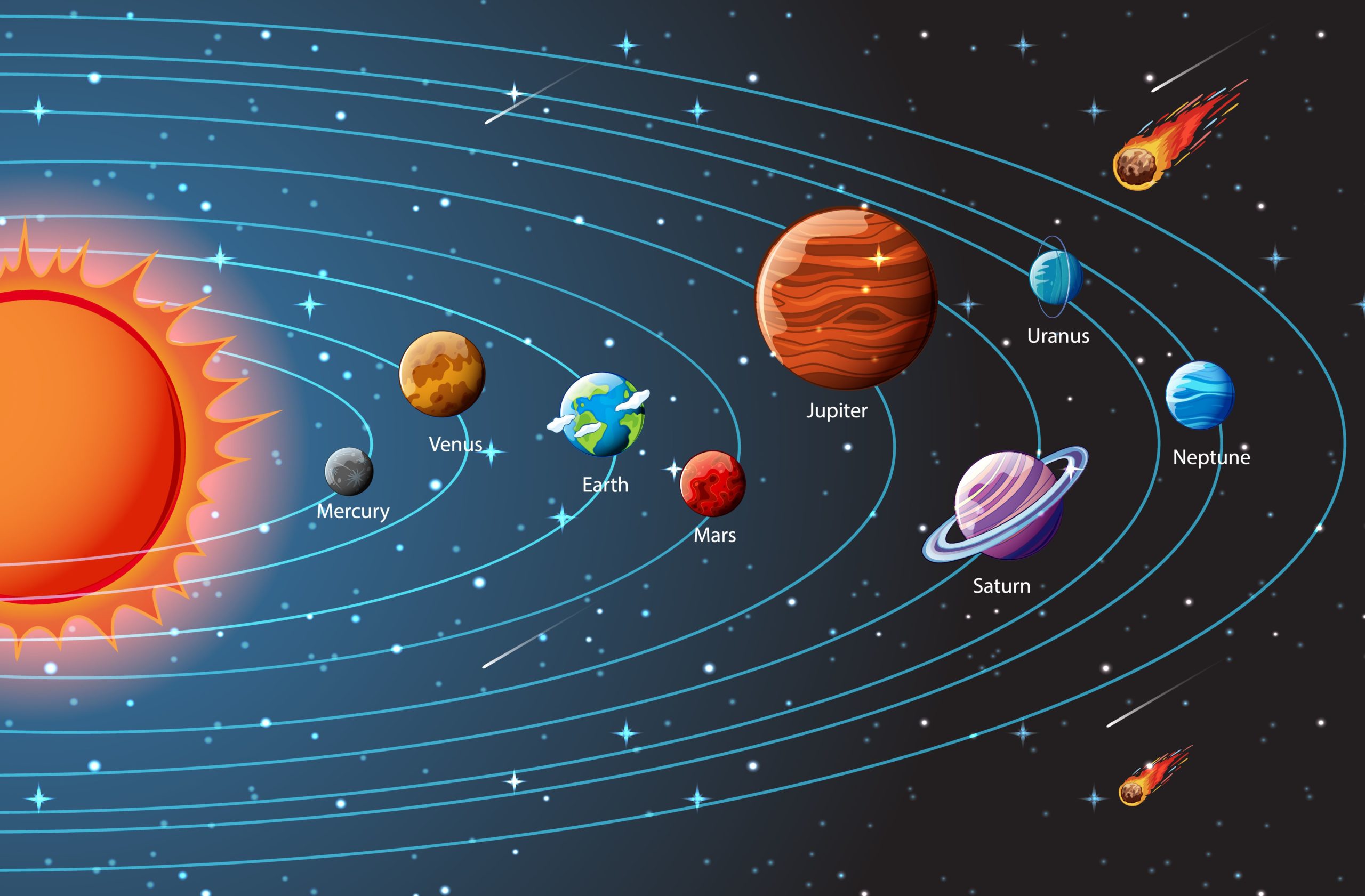IHey there, young space enthusiasts! Today, let’s take a fascinating journey to discover what the solar system is all about. Buckle up, because we’re about to explore the wonders of the universe in simple words made just for you!
What is the Solar System?
Imagine a giant cosmic playground, and you’ve got the solar system! It’s like a super space family where everyone, from the biggest to the smallest, dances around the Sun. It’s not just planets; there are moons, asteroids, comets, and more – each playing a unique role in the cosmic ballet.
The Sun – Our Stellar Superstar
At the heart of it all is the Sun, a massive ball of hot, glowing gas. It’s not just a giant light bulb; it’s also a star! The Sun provides the warmth and light that make life on Earth possible.
Planets: Diverse Worlds in Orbit
As mentioned earlier, we have eight planets orbiting the Sun. They come in all shapes and sizes. Some, like Earth, are just right for life, while others are gas giants or icy giants. Each planet has its own personality, with unique features and mysteries waiting to be unraveled.
Moons – Cosmic Companions
Many planets have their own moons – Earth has one (hello, Moon!), while Jupiter has a whopping 79! Moons are like the sidekicks of the planets, orbiting around them and sometimes even influencing their behavior.
Asteroids and Comets – Space Wanderers
Asteroids are rocky objects that zoom around in space, and comets are icy bodies with long tails that sparkle as they approach the Sun. They add a dash of unpredictability to our solar system, often surprising astronomers with their appearances.
The Kuiper Belt and Oort Cloud – Distant Frontiers
Beyond Neptune, the last of the official planets, lies the Kuiper Belt, a region filled with small, icy objects like Pluto. Even farther out is the Oort Cloud, a hypothetical zone of icy bodies that’s like the solar system’s edge.
Space Travel – Exploring Our Cosmic Backyard
Humans have built amazing machines that have traveled to some of our neighboring planets and even beyond. Space probes and telescopes help scientists learn more about our solar system and the vast universe.
Whether you dream of being an astronaut or an astronomer, there’s always something new to explore in the great expanse of space.
Meet the Planets
Now, let’s talk about the main characters in our cosmic show – the planets! There are eight planets in our solar system. Yes, eight! They are Mercury, Venus, Earth, Mars, Jupiter, Saturn, Uranus, and Neptune.
Mercury – the closest planet to the Sun
It has extreme temperature variations, with scorching hot days and freezing nights. Despite its small size, Mercury boasts a rocky surface with cliffs and craters. There’s no atmosphere to speak of, so it doesn’t have the protective blanket that keeps us warm on Earth. Mercury completes a full orbit around the Sun in approximately 88 Earth days.
Venus – Earth’s “sister planet”
Venus has a thick atmosphere made mostly of carbon dioxide, trapping heat and making it the hottest planet in our solar system. It rotates very slowly, taking longer to complete one rotation than it does to orbit the Sun. Its surface is rocky and dotted with volcanoes, giving it a unique landscape. Venus is visible as the bright “morning star” or “evening star” depending on its position relative to Earth.
Earth – our home
Earth has a diverse environment, with oceans, mountains, and a variety of ecosystems. The presence of a life-supporting atmosphere, water, and just the right distance from the Sun makes Earth special. It takes about 365 days for Earth to orbit the Sun, giving us our calendar year. Earth is the only known celestial body with a rich diversity of life, from tiny microorganisms to large animals and humans.
Mars – The Red Planet
Mars, often called the “Red Planet,” gets its color from iron oxide, giving it a rusty appearance. It has a thin atmosphere, mostly carbon dioxide, and its surface is home to the tallest volcano and the longest canyon in the solar system. Mars has intrigued scientists for possible signs of past water flows, suggesting the potential for life. Numerous spacecraft and rovers have been sent to explore Mars, unraveling its mysteries.
Jupiter – The Giant Among Planets
Jupiter is the largest planet in our solar system, a gas giant with a thick atmosphere .It has a strong magnetic field and a family of at least 79 moons, with four large ones known as the Galilean moons: Io, Europa, Ganymede, and Callisto. Its rapid rotation gives it a flattened appearance at the poles. Jupiter plays a crucial role in shaping the structure of the solar system through its immense gravitational influence.
Saturn
It is known for its stunning ring system. These rings, made up of icy particles and rocks, encircle the planet and are visible even with a small telescope from Earth. Saturn is a gas giant, primarily composed of hydrogen and helium, and has a notably low density, meaning it could theoretically float on water if there were a bathtub big enough.
Uranus – the Ice Giant
Uranus ,the seventh planet from the Sun, is a unique ice giant in our solar system. It is distinct for rotating on its side, almost like it’s rolling through space. This tilt causes extreme seasons, with each pole experiencing 42 years of continuous daylight followed by 42 years of darkness.
Neptune – Blue Ice Giant
Neptune ,the eighth and farthest planet from the Sun, is a vibrant blue ice giant.
It features strong winds, some of the fastest in the solar system, racing around its atmosphere. Neptune’s atmosphere is composed mainly of hydrogen, helium, and traces of methane, giving it its striking blue color.
But hey, there used to be nine planets, and Pluto was one of them. However, scientists decided that Pluto didn’t quite fit the criteria to be a planet, so it became something called a “dwarf planet.” So, we now officially have eight planets in our solar system.
Why Isn’t Pluto a Planet?
Pluto got the boot from the planet club because it’s quite small compared to the other planets. Scientists decided to be more specific about what makes a planet a planet, and Pluto didn’t quite meet all the requirements.
Don’t worry, Pluto didn’t vanish! It’s still out there, orbiting the Sun in the Kuiper Belt, which is like a cool zone of small, icy objects beyond Neptune. Pluto might not be a planet, but it’s definitely part of the solar system.
Order of the Planets
Okay, here’s a cool trick to remember the order of the planets. Just remember this fun sentence: “My Very Educated Mother Just Served Us Noodles.” Each word in this sentence stands for a planet in order from the Sun!
So, starting with the one closest to the Sun, it goes like this:
- Mercury
- Venus
- Earth
- Mars
- Jupiter
- Saturn
- Uranus
- Neptune
Sorry, Pluto, you’re not in the planet club anymore, but you’re still pretty awesome!
So, there you have it, young astronomers! Our solar system is a fantastic place with the Sun as its shining star, and all the planets twirling around like the coolest dance party ever. Keep looking up at the night sky, and who knows what other amazing discoveries you might make in the vastness of space!

